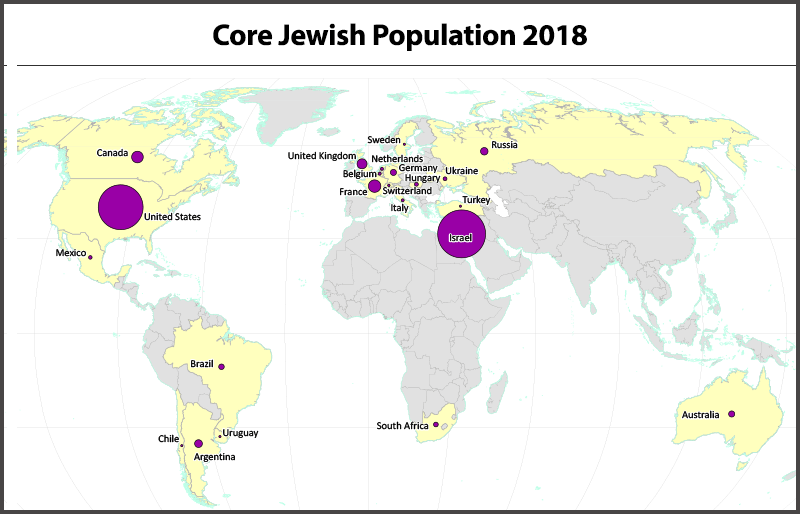Restoring a Pre-Holocaust Lost Population
 |
The arrival and processing of an entire transport
of Jews from Carpatho-Ruthenia, a region annexed in 1939 to Hungary from
Czechoslovakia, at Auschwitz-Birkenau extermination camp in Poland, in
May of 1944. The picture was donated to Yad Vashem in 1980 by Lili
Jacob. AP Photo/Yad Vashem Photo Archives |
"The Jewish population has not returned to what it was before the war, so this is quite impressive to think that the Holocaust of the Jews is still visible. The damage is still visible and not yet recovered to its early dimensions.""[Declining numbers in countries are attributed to] low birth rates, frequent intermarriage, identificational drift, aging, and emigration.""[COVID-19] caused dramatic increase in the cases of death and decline in certain parts of the world, slowing [the] rate of growth.""Jews who also hold another religious identification [are excluded from the tally along with] non-Jews of Jewish ancestry [and non-Jews with] family connections to Jews.""[A result of living in contemporary society is] much greater interaction with different groups. We wish to keep a definition which is more or less similar to what the situation was in past generations.""If you wish to compare [the Jewish] population of today with a population fifty or 100 years ago, these interactions did not exist very much."Sergio Della Pergola, professor emeritus, co-author, annual survey, Hebrew University, Jerusalem
Israel: 6,153,500 (grew 10.2%)
United States: 5,700,000 (grew 5.1%)
France: 453,000 (shrank 5.6%)
Canada: 395,000 (grew 5.3%)
United Kingdom: 290,000 (shrank 0.3%)
Argentina: 180,300 (shrank 0.8%)
Russia: 172,000 (shrank 11.3%)
Germany: 116,000 (shrank 2.5%)
Australia: 113,400 (grew 1.3%)
Brazil: 93,200 (shrank 2.2%)
"The large Soviet Jewish population in areas that the Germans failed to occupy began to leave in the late 1970s because of discrimination in the U.S.S.R. and the possibility of a better life abroad.""Similar stories on a much smaller scale occurred earlier in several Soviet bloc countries."Professor Daniel Stone, study of Jewish history in the Soviet Union, University of Winnipeg"Throughout history, the inherent weakness of a landless and powerless minority vis-a-vis territorially based societies and their constituted powers often put the Jewish people in a condition of dependency and instability, and translated into powerful ups and downs in the Jewish presence."Institute for Jewish Policy Research study
 |
Jewish deportees in the Drancy transit camp near Paris, France, in 1942, on their last stop before the German concentration camps. Some 13,152 Jews (including 4,115 children) were rounded up by French police forces, taken from their homes to the "Vel d'Hiv", or winter cycling stadium in southwestern Paris, in July of 1942. They were later taken to a rail terminal at Drancy, northeast of the French capital, and then deported to the east. Only a handful ever returned. AFP/Getty Images |
 |
German soldiers question Jews after the Warsaw Ghetto Uprising in 1943. In October 1940, the Germans began to concentrate Poland's population of over 3 million Jews into overcrowded ghettos. In the largest of these, the Warsaw Ghetto, thousands of Jews died due to rampant disease and starvation, even before the Nazis began their massive deportations from the ghetto to the Treblinka extermination camp. The Warsaw Ghetto Uprising -- the first urban mass rebellion against the Nazi occupation of Europe -- took place from April 19 until May 16 1943, and began after German troops and police entered the ghetto to deport its surviving inhabitants. It ended when the poorly-armed and supplied resistance was crushed by German troops. OFF/AFP/Getty Images |
 |
This photo provided by Paris' Holocaust Memorial shows a German soldier shooting a Ukrainian Jew during a mass execution in Vinnytsia, Ukraine, sometime between 1941 and 1943. This image is titled "The last Jew in Vinnitsa", the text that was written on the back of the photograph, which was found in a photo album belonging to a German soldier. AP Photo/USHMM/LOC |

Labels: 'Final Solution', Current World Jewish Population, European Jewry, Genocide, Holocaust, Nazi Extermination
0 Comments:
Post a Comment
<< Home